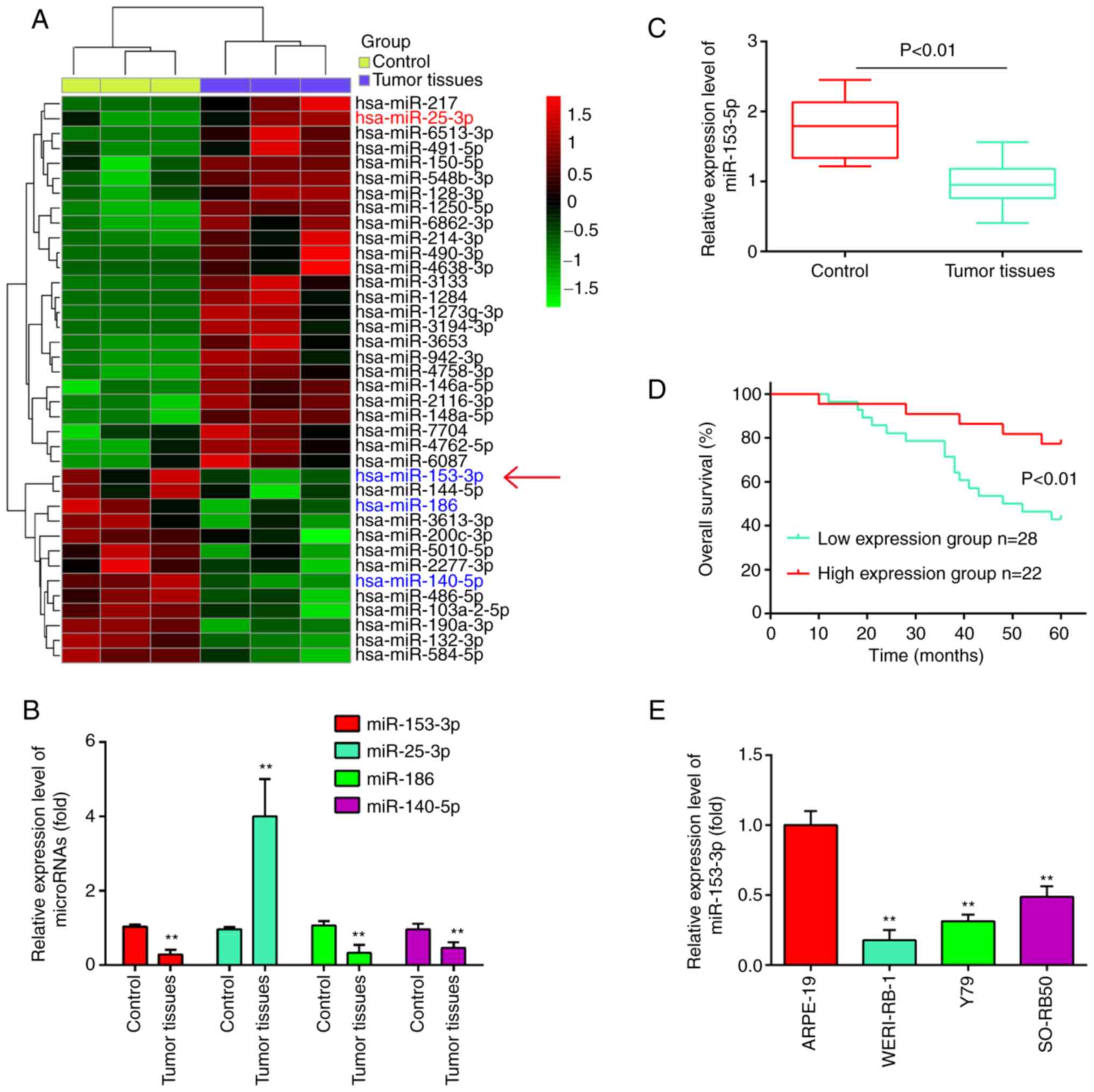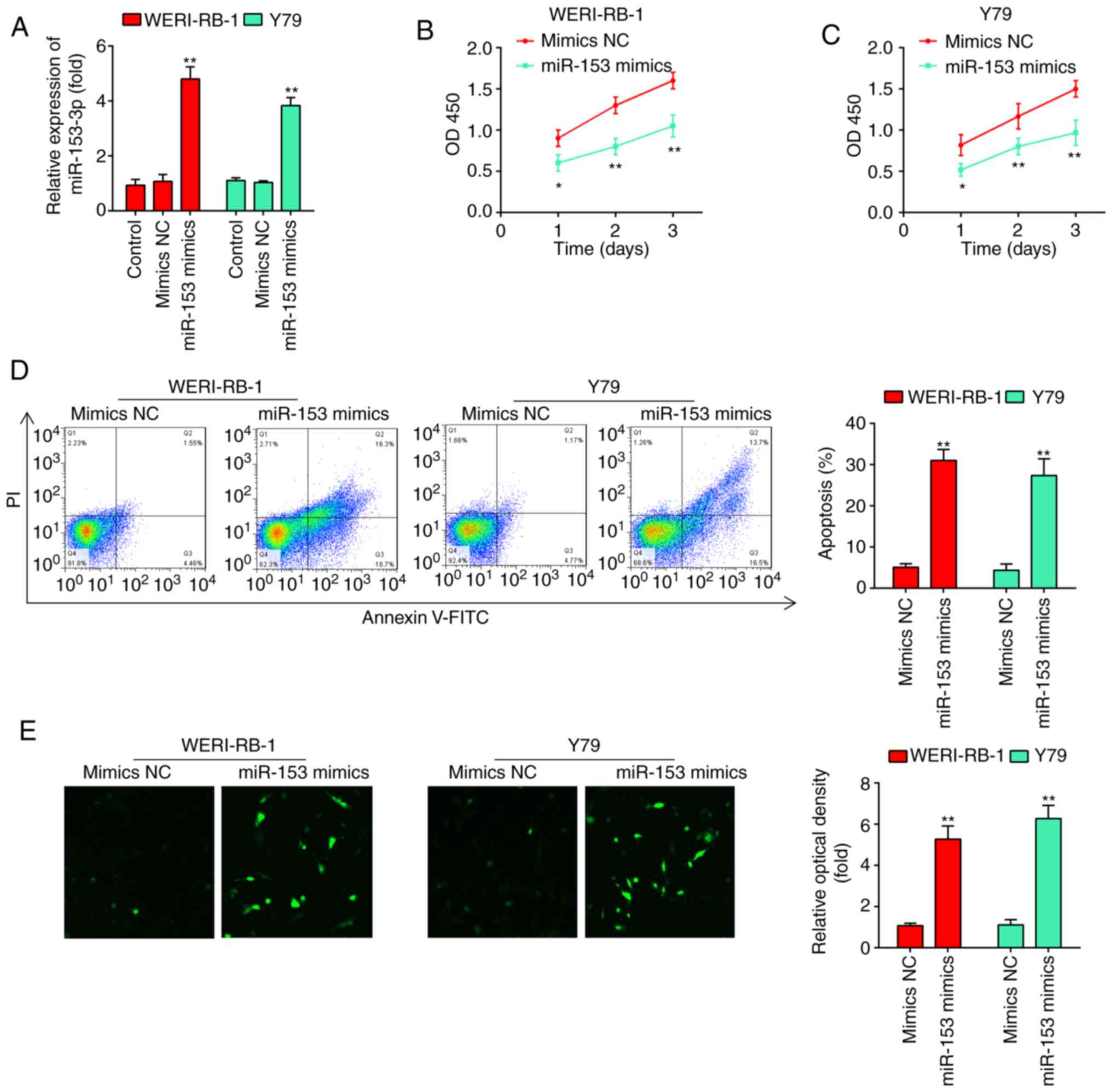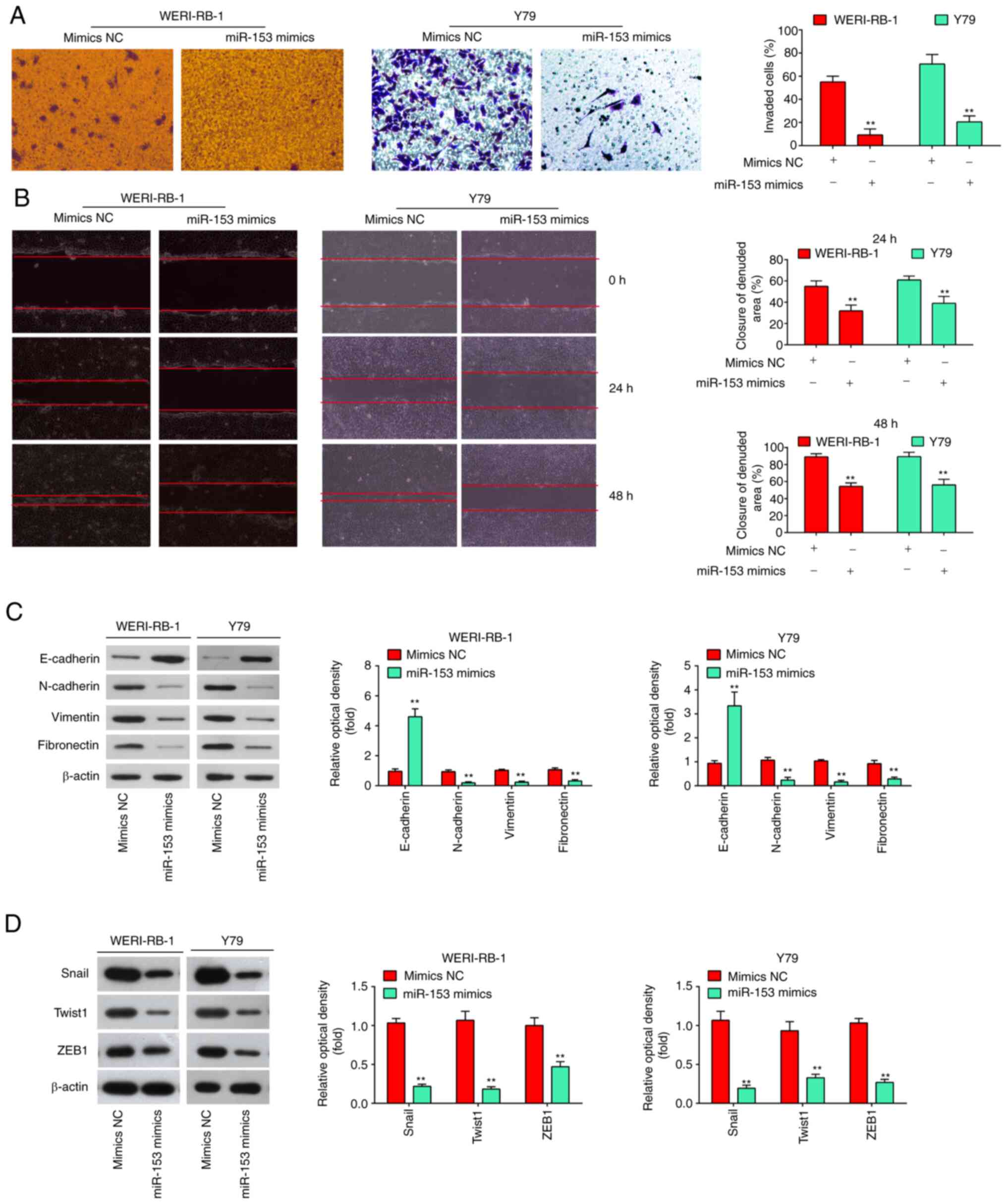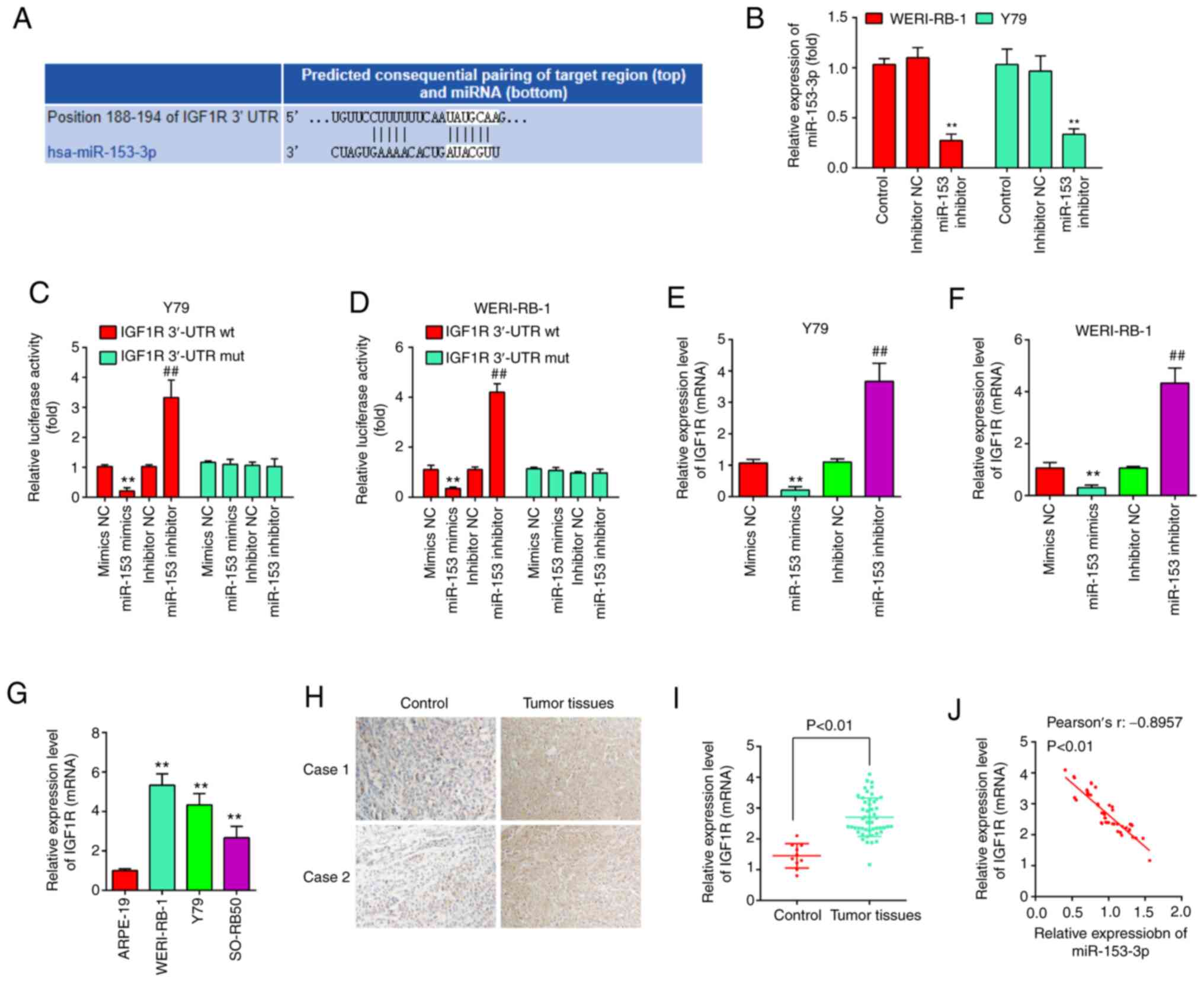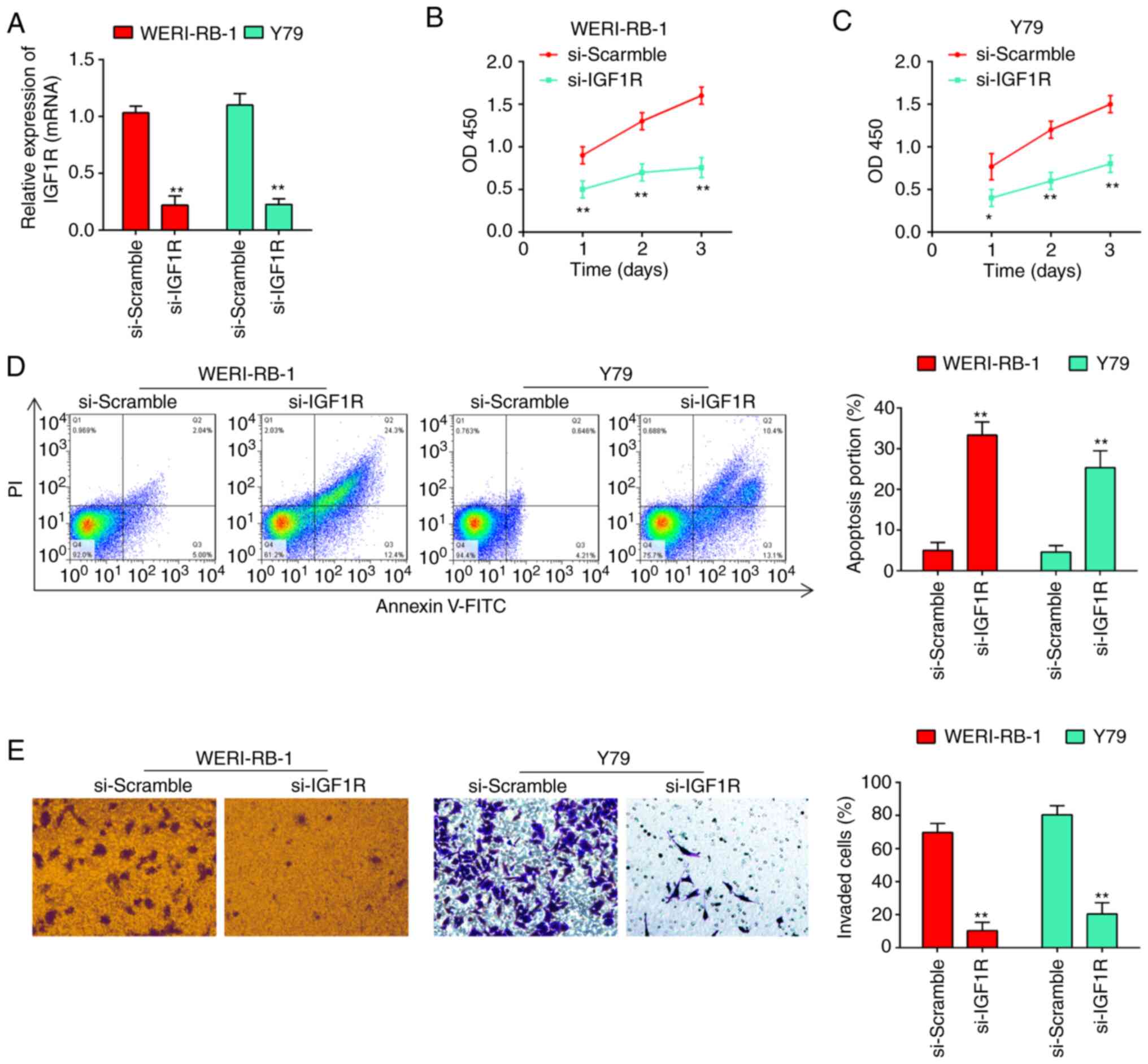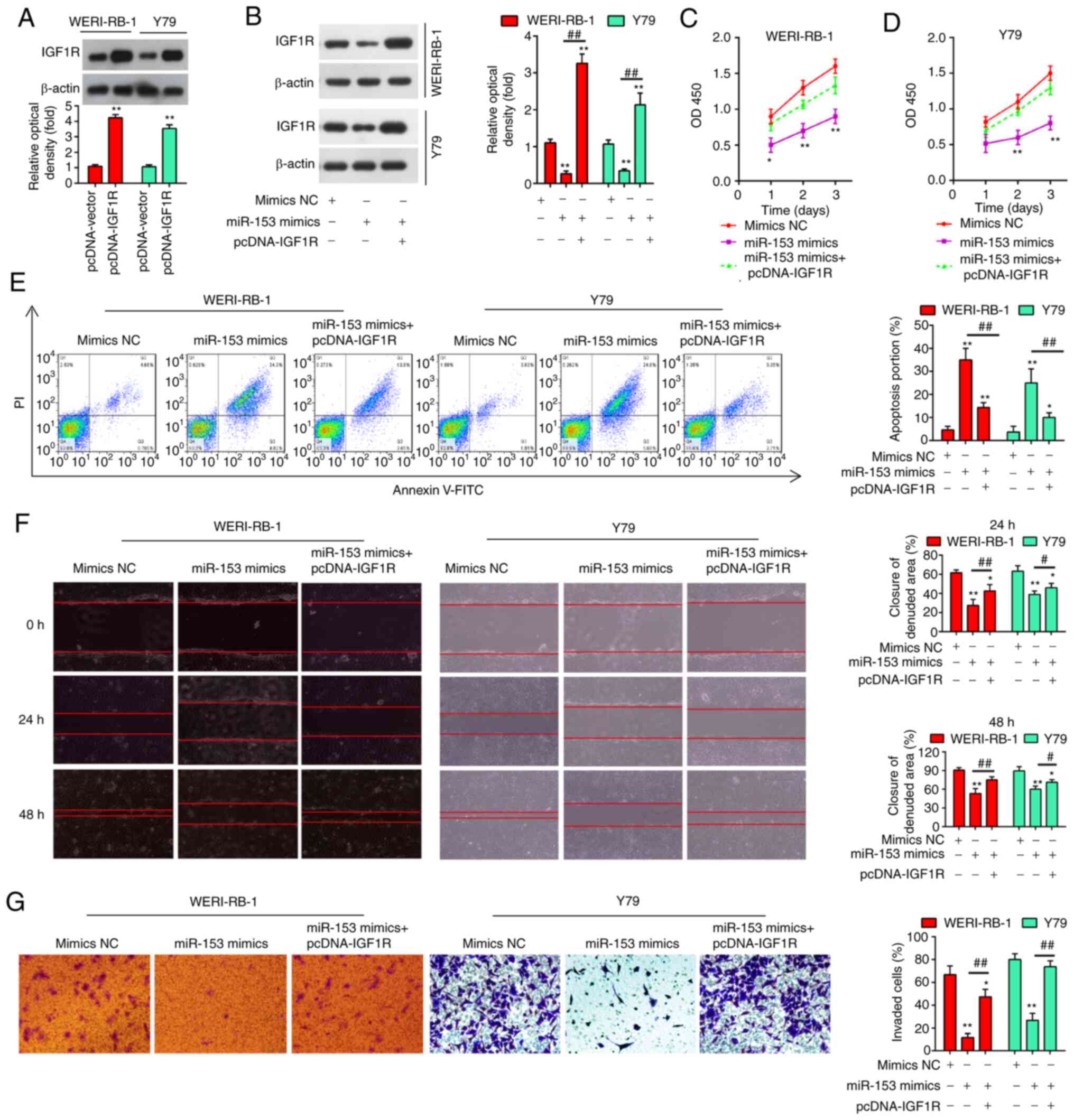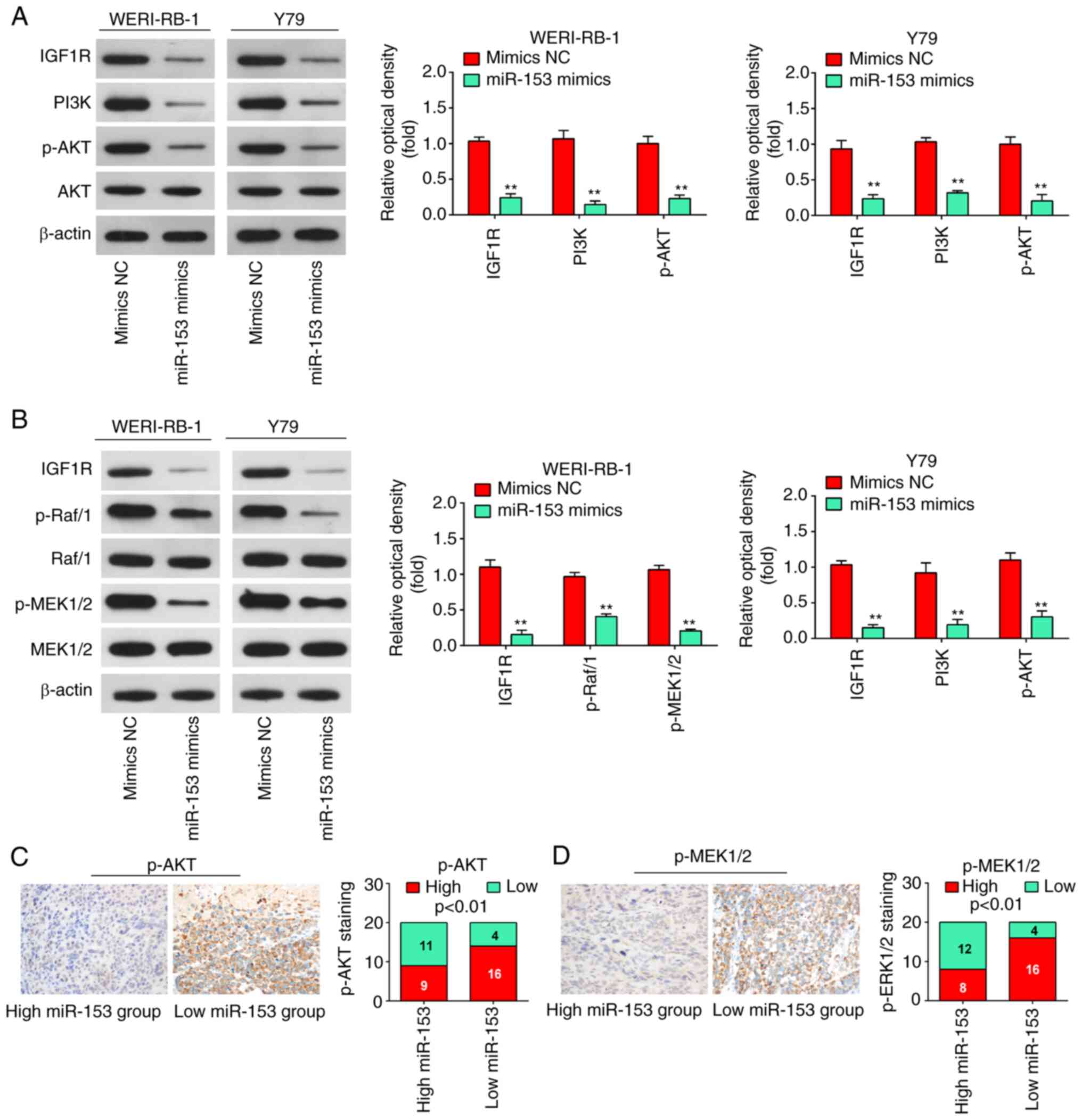|
1
|
Dimaras H, Dimba EA and Gallie BL:
Challenging the global retinoblastoma survival disparity through a
collaborative research effort. Br J Ophthalmol. 94:1415–1416. 2010.
View Article : Google Scholar : PubMed/NCBI
|
|
2
|
Narang S, Mashayekhi A, Rudich D and
Shields CL: Predictors of long-term visual outcome after
chemoreduction for management of intraocular retinoblastoma. Clin
Exp Ophthalmol. 40:736–742. 2012. View Article : Google Scholar : PubMed/NCBI
|
|
3
|
Shields CL and Shields JA: Basic
understanding of current classification and management of
retinoblastoma. Curr Opin Ophthalmol. 17:228–234. 2006. View Article : Google Scholar : PubMed/NCBI
|
|
4
|
Chen HM, Ong SJ, Chao AN, Liou KL, Jung SM
and Kao LY: Histopathologic findings after selective ophthalmic
arterial injection of melphalan for retinoblastoma. Taiwan J
Ophthalmol. 9:262–266. 2019. View Article : Google Scholar
|
|
5
|
Bartel DP: MicroRNAs: Target recognition
and regulatory functions. Cell. 136:215–233. 2009. View Article : Google Scholar : PubMed/NCBI
|
|
6
|
Bartel DP: MicroRNAs: Genomics,
biogenesis, mechanism, and function. Cell. 116:281–297. 2004.
View Article : Google Scholar : PubMed/NCBI
|
|
7
|
Shukla GC, Singh J and Barik S: MicroRNAs:
Processing, maturation, target recognition and regulatory
functions. Mol Cell Pharmacol. 3:83–92. 2011.PubMed/NCBI
|
|
8
|
Croce CM: Causes and consequences of
microRNA dysregulation in cancer. Nat Rev Genet. 10:704–714. 2009.
View Article : Google Scholar : PubMed/NCBI
|
|
9
|
Zuo Z, Ye F, Liu Z, Huang J and Gong Y:
MicroRNA-153 inhibits cell proliferation, migration, invasion and
epithelial-mesenchymal transition in breast cancer via direct
targeting of RUNX2. Exp Ther Med. 17:4693–4702. 2019.PubMed/NCBI
|
|
10
|
Zhang Z, Sun J, Bai Z, Li H, He S, Chen R
and Che X: MicroRNA-153 acts as a prognostic marker in gastric
cancer and its role in cell migration and invasion. Onco Targets
Ther. 8:357–364. 2015.PubMed/NCBI
|
|
11
|
Niu G, Li B, Sun L and An C: MicroRNA-153
inhibits osteosarcoma cells proliferation and invasion by targeting
TGF-β2. PLoS One. 10:e01192252015. View Article : Google Scholar
|
|
12
|
Chen WJ, Zhang EN, Zhong ZK, Jiang MZ,
Yang XF, Zhou DM and Wang XW: MicroRNA-153 expression and prognosis
in non-small cell lung cancer. Int J Clin Exp Pathol. 8:8671–8675.
2015.PubMed/NCBI
|
|
13
|
Jiang J, Liu Y, Zhao Y, Tian F and Wang G:
miR-153-3p suppresses inhibitor of growth protein 2 expression to
function as tumor suppressor in acute lymphoblastic leukemia.
Technol Cancer Res Treat. 18:15330338198529902019. View Article : Google Scholar : PubMed/NCBI
|
|
14
|
Li C, Zhang Y, Zhao W, Cui S and Song Y:
miR-153-3p regulates progression of ovarian carcinoma in vitro and
in vivo by targeting MCL1 gene. J Cell Biochem. 120:19147–19158.
2019. View Article : Google Scholar : PubMed/NCBI
|
|
15
|
Liang H, Ge F, Xu Y, Xiao J, Zhou Z, Liu R
and Chen C: miR-153 inhibits the migration and the tube formation
of endothelial cells by blocking the paracrine of angiopoietin 1 in
breast cancer cells. Angiogenesis. 21:849–860. 2018. View Article : Google Scholar : PubMed/NCBI
|
|
16
|
Livak KJ and Schmittgen TD: Analysis of
relative gene expression data using real-time quantitative PCR and
the 2(-Delta Delta C(T)) method. Methods. 25:402–408. 2001.
View Article : Google Scholar
|
|
17
|
Villar J, Cabrera-Benitez NE, Valladares
F, García-Hernández S, Ramos-Nuez Á, Martín-Barrasa JL, Muros M,
Kacmarek RM and Slutsky AS: Tryptase is involved in the development
of early ventilator-induced pulmonary fibrosis in sepsis-induced
lung injury. Crit Care. 19:1382015. View Article : Google Scholar : PubMed/NCBI
|
|
18
|
Wan W, Wan W, Long Y, Li Q, Jin X, Wan G,
Zhang F, Lv Y, Zheng G, Li Z and Zhu Y: MiR-25-3p promotes
malignant phenotypes of retinoblastoma by regulating PTEN/Akt
pathway. Biomed Pharmacother. 118:1091112019. View Article : Google Scholar : PubMed/NCBI
|
|
19
|
Wu S, Han M and Zhang C: Overexpression of
microRNA-186 inhibits angiogenesis in retinoblastoma via the
hedgehog signaling pathway by targeting ATAD2. J Cell Physiol.
234:19059–19072. 2019. View Article : Google Scholar : PubMed/NCBI
|
|
20
|
Liao Y, Yin X, Deng Y and Peng X:
MiR-140-5p suppresses retinoblastoma cell growth via inhibiting
c-Met/AKT/mTOR pathway. Biosci Rep. 38:BSR201807762018. View Article : Google Scholar : PubMed/NCBI
|
|
21
|
Shan N, Shen L, Wang J, He D and Duan C:
MiR-153 inhibits migration and invasion of human non-small-cell
lung cancer by targeting ADAM19. Biochem Biophys Res Commun.
456:385–391. 2015. View Article : Google Scholar
|
|
22
|
Thiery JP: Epithelial-mesenchymal
transitions in tumour progression. Nat Rev Cancer. 2:442–454. 2002.
View Article : Google Scholar : PubMed/NCBI
|
|
23
|
Guarino M: Epithelial-mesenchymal
transition and tumour invasion. Int J Biochem Cell Biol.
39:2153–2160. 2007. View Article : Google Scholar : PubMed/NCBI
|
|
24
|
Hakuno F and Takahashi SI: IGF1 receptor
signaling pathways. J Mol Endocrinol. 61:T69–T86. 2018. View Article : Google Scholar : PubMed/NCBI
|
|
25
|
Zhu S, Soutto M, Chen Z, Blanca Piazuelo
M, Kay Washington M, Belkhiri A, Zaika A, Peng D and El-Rifai W:
Activation of IGF1R by DARPP-32 promotes STAT3 signaling in gastric
cancer cells. Oncogene. 38:5805–5816. 2019. View Article : Google Scholar : PubMed/NCBI
|
|
26
|
Li Z, Pan W, Shen Y, Chen Z, Zhang L,
Zhang Y, Luo Q and Ying X: IGF1/IGF1R and microRNA let-7e
down-regulate each other and modulate proliferation and migration
of colorectal cancer cells. Cell Cycle. 17:1212–1219. 2018.
View Article : Google Scholar : PubMed/NCBI
|
|
27
|
Kooijman R, Lauf JJ, Kappers AC and
Rijkers GT: Insulin-like growth factor induces phosphorylation of
immunoreactive insulin receptor substrate and its association with
phosphatidylinositol-3 kinase in human thymocytes. J Exp Med.
182:593–597. 1995. View Article : Google Scholar : PubMed/NCBI
|
|
28
|
Fu HW, Lin X, Zhu YX, Lan X, Kuang Y, Wang
YZ, Ke ZG, Yuan T and Chen P: Circ-IGF1R has pro-proliferative and
anti-apoptotic effects in HCC by activating the PI3K/AKT pathway.
Gene. 716:1440312019. View Article : Google Scholar : PubMed/NCBI
|
|
29
|
Huang J, Yang Y, Fang F and Liu K: MALAT1
modulates the autophagy of retinoblastoma cell through
miR-124-mediated stx17 regulation. J Cell Biochem. 119:3853–3863.
2018. View Article : Google Scholar
|
|
30
|
Li W, Zhai L, Zhao C and Lv S: MiR-153
inhibits epithelial-mesenchymal transition by targeting metadherin
in human breast cancer. Breast Cancer Res Treat. 150:501–509. 2015.
View Article : Google Scholar : PubMed/NCBI
|
|
31
|
Shi D, Li Y, Fan L, Zhao Q, Tan B and Cui
G: Upregulation of miR-153 inhibits triple-negative breast cancer
progression by targeting ZEB2-mediated EMT and contributes to
better prognosis. Onco Targets Ther. 12:9611–9625. 2019. View Article : Google Scholar
|
|
32
|
Zuo J, Zhao M, Fan Z, Liu B, Wang Y, Li Y,
Lv P, Xing L, Zhang X and Shen H: MicroRNA-153-3p regulates cell
proliferation and cisplatin resistance via Nrf-2 in esophageal
squamous cell carcinoma. Thorac Cancer. 11:738–747. 2020.
View Article : Google Scholar : PubMed/NCBI
|
|
33
|
Zeng HF, Yan S and Wu SF: MicroRNA-153-3p
suppress cell proliferation and invasion by targeting SNAI1 in
melanoma. Biochem Biophys Res Commun. 487:140–145. 2017. View Article : Google Scholar : PubMed/NCBI
|
|
34
|
Scheidegger KJ, Du J and Delafontaine P:
Distinct and common pathways in the regulation of insulin-like
growth factor-1 receptor gene expression by angiotensin II and
basic fibroblast growth factor. J Biol Chem. 274:3522–3530. 1999.
View Article : Google Scholar : PubMed/NCBI
|
|
35
|
Guo L, Bai Y, Ji S and Ma H: MicroRNA-98
suppresses cell growth and invasion of retinoblastoma via targeting
the IGF1R/k-Ras/Raf/MEK/ERK signaling pathway. Int J Oncol.
54:807–820. 2019.PubMed/NCBI
|
|
36
|
Chen Z, Yang H, Nie Y and Xing Y: miR-145
regulates the proliferation and apoptosis of Y79 human
retinoblastoma cells by targeting IGF-1R. Int J Clin Exp Pathol.
11:4331–4338. 2018.PubMed/NCBI
|
|
37
|
Song L, Duan P, Guo P, Li D, Li S, Xu Y
and Zhou Q: Downregulation of miR-223 and miR-153 mediates
mechanical stretch-stimulated proliferation of venous smooth muscle
cells via activation of the insulin-like growth factor-1 receptor.
Arch Biochem Biophys. 528:204–211. 2012. View Article : Google Scholar : PubMed/NCBI
|
|
38
|
Knowlden JM, Hutcheson IR, Barrow D, Gee
JM and Nicholson RI: Insulin-like growth factor-I receptor
signaling in tamoxifen-resistant breast cancer: A supporting role
to the epidermal growth factor receptor. Endocrinology.
146:4609–4618. 2005. View Article : Google Scholar : PubMed/NCBI
|
|
39
|
Rozen F and Pollak M: Inhibition of
insulin-like growth factor I receptor signaling by the vitamin D
analogue EB1089 in MCF-7 breast cancer cells: A role for
insulin-like growth factor binding proteins. Int J Oncol.
15:589–594. 1999.PubMed/NCBI
|
|
40
|
LeRoith D, Werner H, Neuenschwander S,
Kalebic T and Helman LJ: The role of the insulin-like growth
factor-I receptor in cancer. Ann N Y Acad Sci. 766:402–408. 1995.
View Article : Google Scholar : PubMed/NCBI
|
|
41
|
Zhu L: Tumour suppressor retinoblastoma
protein Rb: A transcriptional regulator. Eur J Cancer.
41:2415–2427. 2005. View Article : Google Scholar : PubMed/NCBI
|
|
42
|
Mu G, Liu H, Zhou F, Xu X, Jiang H, Wang Y
and Qu Y: Correlation of overexpression of HMGA1 and HMGA2 with
poor tumor differentiation, invasion, and proliferation associated
with let-7 down-regulation in retinoblastomas. Hum Pathol.
41:493–502. 2010. View Article : Google Scholar
|
|
43
|
Dalgard CL, Gonzalez M, de Niro JE and
O'Brien JM: Differential microRNA-34a expression and tumor
suppressor function in retinoblastoma cells. Invest Ophthalmol Vis
Sci. 50:4542–4551. 2009. View Article : Google Scholar : PubMed/NCBI
|
|
44
|
Ganguly A and Shields CL: Differential
gene expression profile of retinoblastoma compared to normal
retina. Mol Vis. 16:1292–1303. 2010.PubMed/NCBI
|
|
45
|
Maddison LA, Sutherland BW, Barrios RJ and
Greenberg NM: Conditional deletion of Rb causes early stage
prostate cancer. Cancer Res. 64:6018–6025. 2004. View Article : Google Scholar : PubMed/NCBI
|
|
46
|
Hui AM, Li X, Makuuchi M, Takayama T and
Kubota K: Over-expression and lack of retinoblastoma protein are
associated with tumor progression and metastasis in hepatocellular
carcinoma. Int J Cancer. 84:604–608. 1999. View Article : Google Scholar : PubMed/NCBI
|
|
47
|
Guihurt Santiago J, Burgos-Tirado N,
Lafontaine DD, Mendoza Sierra JC, Camacho RH, Vecchini Rodríguez
CM, Morales-Tirado V and Flores-Otero J: Adhesion G protein-coupled
receptor, ELTD1, is a potential therapeutic target for
retinoblastoma migration and invasion. BMC Cancer. 21:532021.
View Article : Google Scholar : PubMed/NCBI
|















